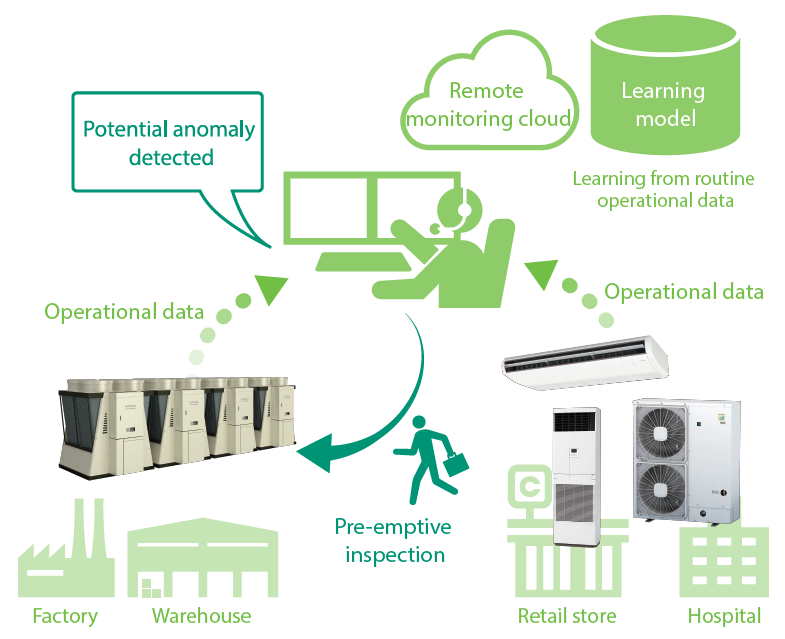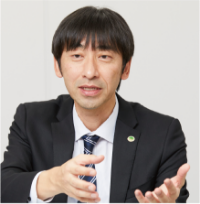Hitachi Global Life Solutions, Inc.

The exiida remote monitoring service can incorporate “HiPAMPS” from Hitachi Power Solutions. This provides predictive diagnosis that works by correlating a wide variety of parameters (coolant pressure, temperatures, currents, and so on) to determine the condition of equipment. It raises an alarm whenever it detects a change that has the potential to develop into a fault. Mr. Tokura was one of the members who worked on the development and operation of the system. He explained as follows how they went about achieving accuracy. “Experienced maintenance staff are able to assess the condition of equipment based on plant data such as pressures or temperatures that change with the seasons, for example. The trick to predictive diagnosis lies in being able to make judgements in this intuitive way that comes naturally to humans. Because the condition of otherwise identical machines varies depending on how they are used and the conditions under which they operate, the starting point for predictive diagnosis is the use of remote monitoring to collect approximately a year’s worth of data on normal plant operation from each customer.
We then analyze this data to produce learning models.”
The availability of past data meant that existing customers of the remote monitoring service were able to adopt predictive diagnosis immediately. On the subject of where the service is used, Mr. Tokura commented that, “A notable application for the predictive diagnosis service is at medical facilities. The cooling systems of MRI and CT scanners necessary to operate continuously due to the heat generated by their magnetic fields. The predictive diagnosis services for keeping these systems running play a very important role in maintaining confidence in healthcare work.”
Mr. Baba also emphasizes the benefits of the system for cost reduction, saying, “Air conditioning maintenance was a significant cost for a retailer that operates nationwide. They became interested in our service as a means of cutting maintenance costs and are currently trialing its use. This is bringing a shift from time-based maintenance to condition-based maintenance practices for things like routine inspections. Parts replacement is one example. Whereas time-based inspections involved replacing all of the parts listed on the inspection instructions, condition-based maintenance performs inspections only when the equipment reports a problem and only replaces the relevant parts. This cuts costs by only replacing parts when necessary. As the system learns from data analysis and from analysis results, it should uncover the keys to further efficiencies.” Along with improving customer satisfaction by reducing the workload of maintenance staff and cutting maintenance costs, predictive diagnosis is also increasingly being seen as a system for ensuring the smooth running of society and industry.
The exiida remote monitoring service can incorporate “HiPAMPS” from Hitachi Power Solutions. This provides predictive diagnosis that works by correlating a wide variety of parameters (coolant pressure, temperatures, currents, and so on) to determine the condition of equipment. It raises an alarm whenever it detects a change that has the potential to develop into a fault. Mr. Tokura was one of the members who worked on the development and operation of the system. He explained as follows how they went about achieving accuracy. “Experienced maintenance staff are able to assess the condition of equipment based on plant data such as pressures or temperatures that change with the seasons, for example. The trick to predictive diagnosis lies in being able to make judgements in this intuitive way that comes naturally to humans. Because the condition of otherwise identical machines varies depending on how they are used and the conditions under which they operate, the starting point for predictive diagnosis is the use of remote monitoring to collect approximately a year’s worth of data on normal plant operation from each customer.
We then analyze this data to produce learning models.”

The emergence of the exiida remote monitoring service was ahead of its time. Work has now moved on to the identification of faulty components and the prediction of equipment life, two features that Hitachi Power Solutions has already rolled out in its solutions. Mr. Tokura explained by saying, “From a customer’s perspective, what you want to know when a potential fault arises are things like where the problem lies and how much time there is before the fault actually happens. We hope to use HiPAMPS to provide a more fine-grained response to these needs.” Meanwhile, what is also necessary is action on pricing to make the service more attractive. Mr. Baba laid out the plans for its future by saying, “With remote monitoring still being expensive, there are customers who have yet to adopt it despite recognizing the need. Along with offering a combined proposition that integrates products and services in the form of cooling, heating, and uninterrupted operation, we are also seeking to reduce the cost to a level that will make the service more attractive. Moreover, we hope to build on our successes in Japan to deploy the service globally through collaborative creation with overseas vendors.”Now equipped with predictive diagnosis, the exiida remote monitoring service is making an important contribution to society and industry. The plan for the future is to work closely with Hitachi Power Solutions to exploit group synergies further.

Hitachi Global Life Solutions, Inc.